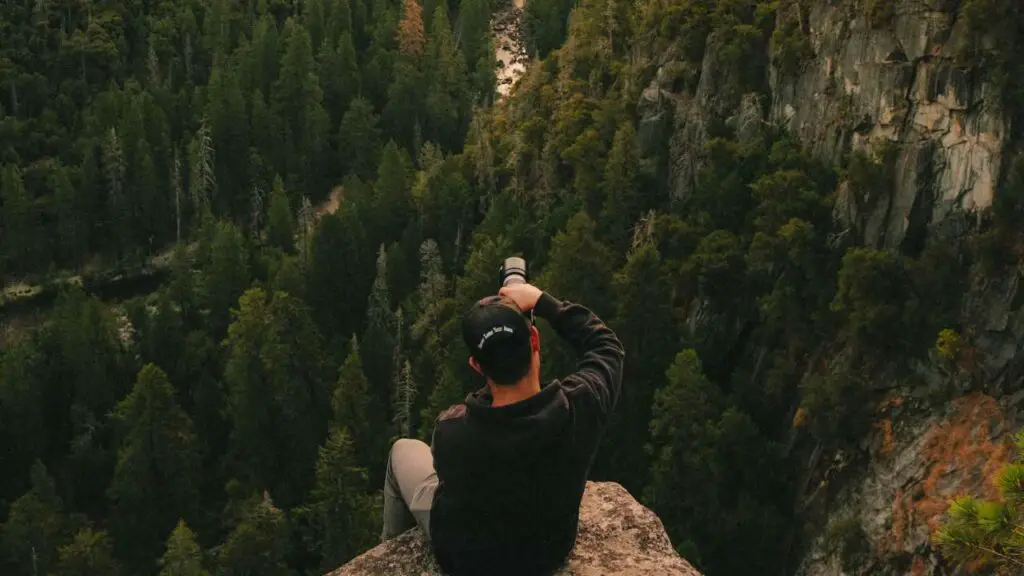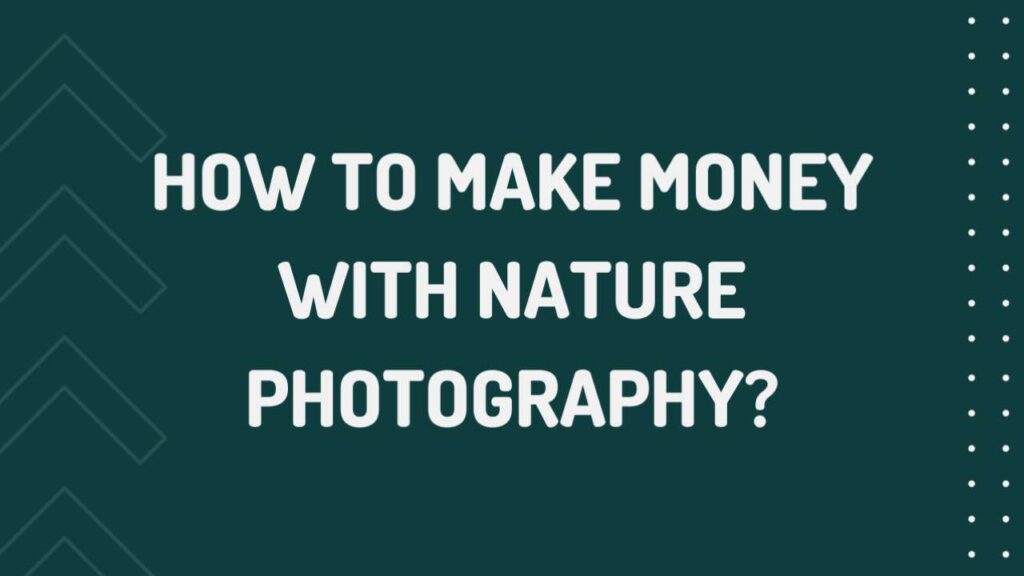THIS ARTICLE MAY CONTAIN AFFILIATE MARKETING LINKS! IN CASE YOU MAKE A PURCHASE THROUGH ONE OF THE LINKS, WE'LL GET A SMALL COMMISSION. WITH NO EXTRA CHARGES TO YOU. THANKS!!
Making money with nature photography can be a rewarding endeavor. Whether you’re a professional photographer or someone passionate about capturing the beauty of the natural world, there are several avenues to explore. Here are some ways to monetize your nature photography. Let’s explore how to make money with nature photography.
- How to make money with Nature Photography?
- Stock Photography
- Prints and Art Sales
- Select Your Best Shots
- Choose Print Sizes and Formats
- Printing and Framing
- Pricing Your Prints
- Create an Online Presence
- High-Quality Imagery for Marketing
- Write Compelling Descriptions
- Market Your Artwork
- Customer Service and Shipping
- Engage with Your Audience
- Expand Your Product Line
- Stay Committed and Adaptable
- Photography Workshops
- Define Your Workshop Niche
- Plan Your Curriculum
- Select Locations and Dates
- Set Workshop Duration and Size
- Gather Necessary Equipment
- Price Your Workshops
- Market Your Workshops
- Online Promotion and Registration
- Teaching and Communication Skills
- Provide Personal Feedback
- Safety and Environmental Awareness
- Gather Testimonials and Referrals
- Evaluate and Improve
- Legal Considerations
- Photo Contests
- Choose the Right Contests
- Read the Rules and Guidelines
- Theme and Concept
- Quality Over Quantity
- Post-Processing Skills
- Copyright and Releases
- Image Size and Format
- Caption and Description
- Watermark Consideration
- Legal Considerations
- Online Submission
- Judging Criteria
- Multiple Submissions
- Public Voting Contests
- Stay Informed
- Learn from Rejections
- Promote Your Entry
- Social Media and Blogging
How to make money with Nature Photography?
Stock Photography
Stock nature photography is a popular and viable way to earn money with your passion for capturing the beauty of the natural world. Here’s a guide to help you get started and succeed in the stock photography industry:
Create a Diverse Portfolio:
- Quality Matters: Ensure your photos are of high quality, well-composed, and properly exposed.
- Diversity in Subjects: Capture a variety of nature subjects including landscapes, wildlife, plants, and natural phenomena. Stock agencies look for a wide range of themes.
- Technical Excellence: Pay attention to details. Make sure your images are sharp and free from noise.
Research and Choose the Right Stock Platforms:
- Popular Stock Websites: Submit your photos to reputable stock photography websites like Shutterstock, Adobe Stock, Getty Images, Alamy, and iStock. Each platform has its submission guidelines and payment structures.
- Exclusive or Non-Exclusive: Decide whether you want to sell your photos exclusively on one platform or non-exclusively on multiple platforms. Exclusivity often offers higher commission rates.
Understanding Stock Licenses:
- Royalty-Free vs. Rights-Managed: Understand the difference between these licensing models. Most stock nature photos are sold under royalty-free licenses, meaning buyers pay once to use the image multiple times.
Metadata and Keywords:
- Accurate Descriptions: Provide accurate and detailed descriptions of your photos. Include information about the location, subjects, and any relevant details.
- Keywords: Use relevant and specific keywords that buyers might use when searching for nature photos. Be descriptive and avoid irrelevant keywords.
Legal and Ethical Considerations:
- Model and Property Releases: If your photos feature recognizable people or private property, you need model and/or property releases to sell them commercially.
- Avoid Trademarks: Be cautious about capturing logos, brand names, or trademarks in your images. These can lead to legal complications.
Consistency and Regular Uploads:
- Consistency is Key: Regularly upload new photos to keep your portfolio fresh and appealing to buyers. Stock agencies often reward active contributors.
- Seasonal and Trendy Content: Capture seasonal nature scenes and stay aware of current trends in photography. These can be in high demand.
Promote Your Portfolio:
- Social Media: Share your work on social media platforms. Instagram, Pinterest, and Facebook are great for showcasing visual content.
- Personal Website: Consider having a personal website to display your portfolio and direct potential buyers to stock agencies where your images are available.
Patience and Persistence:
- Be Patient: Earning a significant income from stock photography takes time. It may take a while to build a substantial portfolio and client base.
- Learn from Rejections: Don’t get discouraged by rejections. Instead, learn from feedback provided by stock agencies to improve your skills and submissions.
Prints and Art Sales
Selling prints and art derived from your nature photography is a wonderful way to not only share your passion with others but also to earn money from your creative endeavors. Here’s a guide on how to get started with selling prints and art based on your nature photographs:
Select Your Best Shots
- Begin by curating a selection of your most captivating nature photographs. These should be images that you believe would resonate with potential buyers.
Choose Print Sizes and Formats
- Determine the sizes and formats for your prints. Consider popular options like canvas prints, framed prints, posters, or digital downloads. Make sure your selections are consistent with the aesthetic and style of your work.
Printing and Framing
- Depending on your budget and resources, you can either invest in professional-grade printing equipment or partner with a print-on-demand service. Many online platforms, like Fine Art America, Printful, or Redbubble, offer printing and fulfillment services, allowing you to focus on creating and marketing your art.
Pricing Your Prints
- Set reasonable and competitive prices for your prints. Consider factors like the cost of production, your time and effort, and the perceived value of your artwork. Research what similar prints in the market are priced at to get a sense of the competition.
Create an Online Presence
- Build a website or use an e-commerce platform to showcase and sell your prints. If you prefer not to manage your own website, you can utilize popular online marketplaces like Etsy, Society6, or even your social media profiles.
High-Quality Imagery for Marketing
- Ensure that the images of your prints are of high quality. Potential buyers should see clear, well-lit representations of your work. High-resolution images can help sell your art.
Write Compelling Descriptions
- Craft engaging and informative descriptions for each piece of art. Share the story behind the image, your inspiration, and any relevant details about the subject matter.
Market Your Artwork
- Promote your work through social media, blogs, email newsletters, and any other marketing channels you have access to. Engage with your audience by sharing your creative process and the stories behind your photographs.
Customer Service and Shipping
- Provide excellent customer service and ensure reliable shipping and packaging for your prints. Satisfied customers are more likely to return or recommend your work to others.
Engage with Your Audience
- Respond to inquiries and feedback promptly. Building a personal connection with your customers can lead to repeat business and word-of-mouth referrals.
Expand Your Product Line
- As your art sales grow, consider expanding your product line. You can offer different products like calendars, greeting cards, or even limited edition prints to attract a wider range of buyers.
Stay Committed and Adaptable
- Building a successful art-selling business takes time and persistence. Stay committed to your craft and be open to adapting your strategies based on what works best for your audience.

- How to make money as a Video Editor?
- How to make money as Web Developer?
- How to make money with Canva?
Photography Workshops
Photography workshops are an excellent way to share your expertise in nature photography while also generating income. If you’re passionate about nature photography and want to teach others, here’s how to get started with hosting photography workshops:
Define Your Workshop Niche
- Determine the specific focus of your workshop. Are you teaching landscape photography, wildlife photography, macro photography, or a combination? Identifying your niche helps you target the right audience.
Plan Your Curriculum
- Develop a detailed curriculum that covers essential photography techniques and skills relevant to your chosen niche. Consider including topics like composition, lighting, camera settings, and post-processing.
Select Locations and Dates
- Choose picturesque natural locations for your workshops. Depending on the duration, plan the workshop dates and consider seasonal and weather factors that could affect the quality of photography.
Set Workshop Duration and Size
- Determine how long each workshop will last. It can range from a single day to several days. Decide on the maximum number of participants to ensure a manageable and personalized experience for attendees.
Gather Necessary Equipment
- Make sure you have the right equipment, such as cameras, tripods, and any additional gear that might be needed for participants. Consider loaning or renting equipment to attendees if they don’t have their own.
Price Your Workshops
- Calculate the cost of conducting the workshop, including your time, travel, and any additional expenses. Then set a competitive price for your workshops. Research what similar workshops in your niche charge.
Market Your Workshops
- Create a professional-looking website or use workshop hosting platforms like Eventbrite or Meetup to advertise your workshops. Promote your workshops through social media, photography forums, and email newsletters. Consider paid advertising if your budget allows.
Online Promotion and Registration
- Use social media and your website to promote your workshops. Set up an easy and secure online registration process where participants can sign up and pay for the workshops.
Teaching and Communication Skills
- As an instructor, you’ll need good communication and teaching skills. Be patient, adaptable, and able to explain complex photography concepts in a clear and relatable manner.
Provide Personal Feedback
- Offer individualized feedback to workshop participants, reviewing their work and providing constructive critiques. This personalized approach can greatly enhance the learning experience.
Safety and Environmental Awareness
- If you’re conducting workshops in natural settings, prioritize safety and environmental ethics. Educate your participants about respecting nature and wildlife during the workshops.
Gather Testimonials and Referrals
- Encourage participants to provide feedback and testimonials after your workshops. Positive testimonials can be valuable for future marketing efforts.
Evaluate and Improve
- After each workshop, assess what went well and what could be improved. Use this feedback to enhance the quality of your future workshops.
Legal Considerations
- Depending on your location, you may need to address legal considerations, such as liability insurance or permits for using specific locations for workshops. Consult with a legal professional if necessary.
Photo Contests
Participating in photo contests is an excellent way to showcase your nature photography skills, gain recognition, and potentially earn prizes or money. Here’s a guide on how to get involved in photo contests and maximize your chances of success:
Choose the Right Contests
- Research and select photo contests that align with your style and interests. There are various contests dedicated to nature and wildlife photography.
Read the Rules and Guidelines
- Carefully review the contest rules, guidelines, and submission criteria. Pay attention to entry fees, deadlines, and specific themes or requirements.
Theme and Concept
- Understand the theme or concept of the contest. Ensure your submission resonates with the theme, as judges look for images that match the intended focus.
Quality Over Quantity
- Prioritize quality over quantity. Submit your best shots that showcase your technical and artistic skills. One outstanding image often has a better chance of winning than multiple mediocre ones.
Post-Processing Skills
- If post-processing is allowed, use your editing skills to enhance the image while maintaining its natural look. However, avoid over-processing or heavy manipulation.
Copyright and Releases
- Ensure you have the right to submit the photo. If it features recognizable people or private property, you may need model and property releases.
Image Size and Format
- Follow the contest’s specifications for image size, format, and resolution. Most contests require high-resolution images.
Caption and Description
- Write a captivating and informative caption or description for your photo. Provide insights into the context, location, and your creative process.
Watermark Consideration
- Decide whether to add a watermark to your image. Some photographers use watermarks to protect their work, while others prefer not to have any.
Legal Considerations
- Be aware of copyright laws and contest terms regarding image ownership. Ensure you retain the rights to your photograph after submission.
Online Submission
- Carefully upload your photos following the contest’s online submission process. Double-check that all the details, including your contact information, are accurate.
Judging Criteria
- Familiarize yourself with the judging criteria. This might include aspects like composition, technical excellence, creativity, and adherence to the theme.
Multiple Submissions
- If the contest allows multiple submissions, consider submitting a variety of images that showcase your range and versatility as a nature photographer.
Public Voting Contests
- In some contests, the public can vote for their favorite photos. Promote your entry on social media and among friends and family to gain more votes.
Stay Informed
- Stay updated on the contest’s progress, including announcements of semifinalists, finalists, and winners. This helps you prepare for potential recognition or prizes.
Learn from Rejections
- Don’t be discouraged by rejections. Instead, view them as opportunities to learn and improve. Seek feedback from judges or other photographers.
Promote Your Entry
- If your photo is selected as a finalist or a winner, share the news on your website, social media, and within your photography community. It can boost your credibility and reach a wider audience.
Social Media and Blogging
Using social media and blogging is a fantastic way to connect with a wider audience and share your passion for nature photography. It can also help you monetize your efforts over time. Here’s a guide on how to effectively leverage social media and blogging for your nature photography:
Social Media:
- Choose the Right Platforms:
- Select the social media platforms that align with your target audience and the type of content you create. Instagram, Facebook, Pinterest, and Twitter are popular choices for photographers.
- Consistent Posting:
- Maintain a regular posting schedule. Consistency helps keep your audience engaged and informed about your work.
- Quality Content:
- Share your best nature photographs. High-quality visuals are essential on social media. Invest in image editing tools to enhance your photos if needed.
- Use Hashtags:
- Research and use relevant and trending hashtags to increase the discoverability of your posts. These can help your content reach a wider audience.
- Engage with Your Audience:
- Respond to comments and messages promptly. Engaging with your followers can build a loyal community around your work.
- Collaborate and Network:
- Collaborate with other photographers or nature enthusiasts. Cross-promotion can help you tap into each other’s audiences.
- Storytelling:
- Share the stories behind your photographs. Explain your adventures, experiences, and the natural beauty you’ve captured.
- Live Streams and Stories:
- Use live streams and stories on platforms like Instagram and Facebook to interact with your audience in real-time. You can host Q&A sessions, behind-the-scenes tours, or image editing demonstrations.
- Contests and Challenges:
- Organize photography contests or challenges for your followers. Encourage them to participate and use a unique hashtag for entries.
- Promote Your Prints and Workshops:
- Promote your print sales and photography workshops through your social media channels. Share links to your website or ecommerce platforms.
Blogging:
- Choose a Blogging Platform:
- Select a blogging platform like WordPress, Blogger, or Medium to host your blog. You can also integrate a blog into your personal photography website.
- Create Valuable Content:
- Write informative and engaging blog posts related to nature photography. Share photography tips, stories from your adventures, and in-depth insights into your creative process.
- SEO Optimization:
- Optimize your blog posts for search engines. Use relevant keywords, meta descriptions, and alt text for images to improve the discoverability of your content.
- Visual Content:
- Accompany your blog posts with your nature photographs. High-quality visuals are crucial for a photography blog.
- Consistent Posting:
- Maintain a regular posting schedule for your blog. Consistency helps build a loyal readership.
- Newsletter Subscription:
- Encourage blog visitors to subscribe to your newsletter. This way, you can notify them of new blog posts, workshops, and other updates.
- Monetization Strategies:
- Incorporate monetization strategies into your blog, such as affiliate marketing, sponsored posts, and selling your photography-related products.
- Cross-Promotion:
- Promote your blog posts on your social media channels and vice versa. Cross-promotion can drive traffic to both platforms.
- Engage with Your Readers:
- Respond to comments on your blog and engage with your readers. Building a community around your blog can lead to loyal followers.
- Guest Posts and Collaborations:
- Collaborate with other photographers or bloggers. You can write guest posts for each other’s blogs, expanding your reach and expertise.
Remember, building a successful career in nature photography takes dedication and patience. It’s crucial to continuously improve your skills, network with fellow photographers, and stay updated with industry trends. Nature photography not only allows you to earn money but also provides a platform to raise awareness about the beauty and importance of the natural world.







